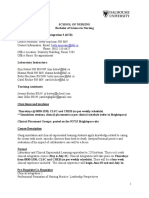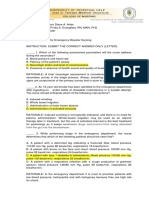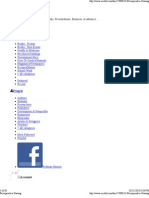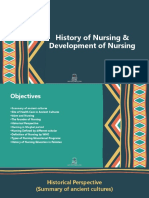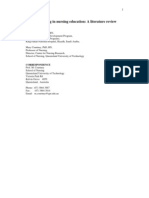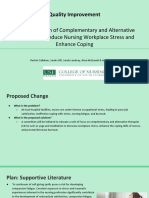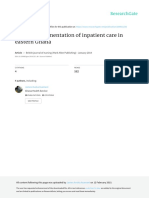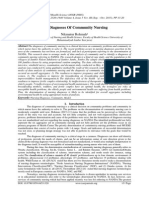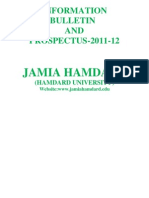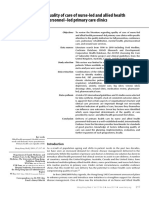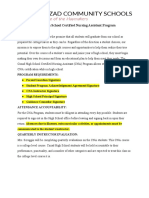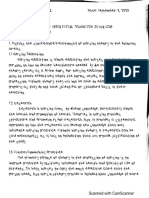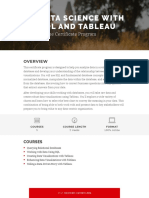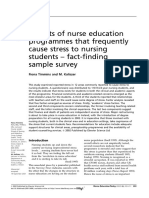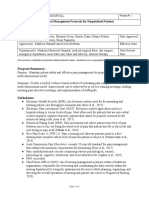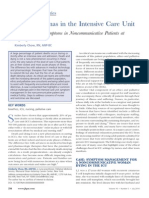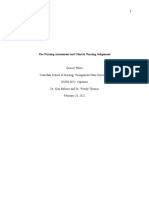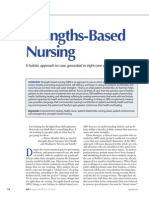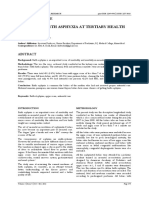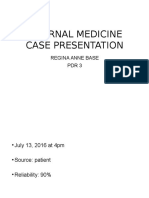Professional Documents
Culture Documents
Lollipop UCLA NursingStudy
Lollipop UCLA NursingStudy
Uploaded by
Sam DyerCopyright
Available Formats
Share this document
Did you find this document useful?
Is this content inappropriate?
Report this DocumentCopyright:
Available Formats
Lollipop UCLA NursingStudy
Lollipop UCLA NursingStudy
Uploaded by
Sam DyerCopyright:
Available Formats
Research Brief
Can a Licorice Lollipop Decrease Cariogenic Bacteria in
Nursing Home Residents?
Janet C. Mentes, PhD, APRN, BC, FGSA; Sarah Kang, MSN, RN; Sue Spackman, DDS; and
Janet Bauer, DDS
ABSTRACT
The purpose of this pilot study was to examine whether an herbal lollipop containing licorice root decreases Streptococcus mutans (S. mutans) bacteria that cause dental caries in nursing home residents. A
total of 8 residents (5 women, 3 men; mean age = 85) consented to participate in this study. Participants
were offered two lollipops per day for 21 days. Saliva samples were collected at baseline and Days 1, 3, 7,
14, and 21, then analyzed for numbers of S. mutans. Using linear mixed-models analysis with difference in
numbers of S. mutans from baseline to any time point as the dependent variable, and number of lollipops
consumed with effect of time controlled as the predictor variable, participants who consumed more lollipops during the 21-day time period were more likely to have fewer numbers of S. mutans (b = 8.703, p
= 0.067). There was a trend toward reduction of S. mutans with consumption of more lollipops during the
21-day period. Recruiting a larger sample for future research may demonstrate a significant reduction.
Consistently providing routine oral hygiene remains a
significant problem for caregivers of nursing home (NH)
residents. Residents specific disabilities, including dementia, dysphagia, and extreme physical frailty, as well as time
constraints on caregivers, makes maintaining oral hygiene
exceptionally difficult (Bauer, Spackman, Chiappelli, &
Prolo, 2008; Coleman & Watson, 2006). Inadequate oral
hygiene has been linked to declines in overall health, specifically between disease found in the oral cavity and that
found systemically throughout the body (Stein & Henry,
2009). Specifically, inflammation-driven diseases, such as
cardiovascular, cerebrovascular, and infectious pathologies,
have been associated with oral disease (Maupom, Gullion,
White, Wyatt, & Williams, 2003; Mojon, Rentsch, BudtzJrgensen, & Baehni, 1998). Additionally, inadequate oral
hygiene influences the nutrition and hydration status of NH
residents, which is an important index of health (Mentes,
2006; U.S. Department of Health & Human Services, 2000).
Dr. Mentes is Associate Professor, School of Nursing, Dr. Spackman is Lecturer and Co-Director, and Dr. Bauer is Professor and Director, June
and Paul Ehrlich Endowed Program in Geriatric Dentistry, School of Dentistry, University of California Los Angeles, and Ms. Kang is CN1, Cedars
Sinai Medical Center, Los Angeles, California.
The authors have disclosed no potential conflicts of interest, financial or otherwise. Dr. Mentes acknowledges a grant from Delta Dental. The
authors gratefully acknowledge the support of Dr. Michelle Eslami for help in recruiting study participants and Dr. Wenyuan Shi and his laboratory
staff for help with the saliva analysis.
Address correspondence to Janet C. Mentes, PhD, APRN, BC, FGSA, Associate Professor, School of Nursing, University of California Los Angeles, 700
Tiverton Avenue, Box 956919, Los Angeles, CA 90095-6919; e-mail: Jmentes@sonnet.ucla.edu.
Received: May 1, 2011; Accepted: January 27, 2012; Posted: September 17, 2012
doi:10.3928/19404921-20120906-07
Research in Gerontological Nursing Vol. x, No. x, 20xx
Mentes et al.
Previous research demonstrates that daily oral hygiene
regimens positively affect the overall health of older adults
(Meurman & Hmlinen, 2006) and NH residents (Samson, Berven, & Strand, 2009; Sjgren, Kullberg, Hoogstraate,
Johansson, Herbst, & Forsell, 2010). However, studies indicate that adequate daily oral self-care is not routinely delivered to this population (Coleman & Watson, 2006). The
lack of oral hygiene is particularly troublesome because not
only are older adults at greater risk for dental caries, respiratory pathogens aspirated from the oropharangeal cavity
have been shown to be major risk factors for pneumonia in
older adults, especially frail older adults who have swallowing difficulties or other functional disabilities (Nishiyama,
Inaba, Uematsu, & Senpuku, 2010; Ohrui, 2005). Yet, many
issues prevent proper adherence with oral care requirements
for NH residents. First, low staffing and little or no training about oral care strategies limit staff members ability to
provide necessary and adequate daily oral care for NH residents. Second, NH caregivers, specifically certified nursing
assistants, may be concerned about being injured while providing care, especially to residents with dementia (Jablonski, Munro, Grap, & Elswick, 2005; Reed, Broder, Jenkins,
Spivack, & Janal, 2006). Thus, there is a need for a simple
adjunctive aid that can be used alone or in addition to oral
care regimens for this population that can eliminate oral
pathogens and preserve normal oral flora for optimal health.
We hypothesized that an herbal lollipop containing whole
licorice extract that demonstrated antimicrobial properties in laboratory studies could potentially help reduce oral
bacterial loads, leading to improvements in the oral health
of NH residents (He, Chen, Heber, Shi, & Lu, 2006; Hu et
al., 2011). The active ingredient in licorice, glycyrrhizin, has
demonstrated many health benefits, including antibacterial
properties, specifically against cariogenic bacteria such as
Streptococcus mutans (S. mutans) (He et al., 2006; Thorne
Research, Inc., 2005). S. mutans are colonized in dental
plaque that naturally occurs on the smooth surfaces of teeth.
When colonized, S. mutans become pathogenic and are
therefore associated with the development of dental caries.
While licorice consumption is rated Generally Recognized as Safe by the U.S. Food and Drug Administration
(1974), with consumption of 1 to 5 grams of licorice per
day considered safe in reasonably healthy adults (Thorne
Research, Inc., 2005), several case reports (age range = 67
to 80) have indicated hypertensive side effects of unmonitored higher amounts of licorice intake from candy or herbal
supplements in older adults (Breidthardt, Namdar, & Hess,
2006; Janse, van Irsel, Hoefnagels, & Olde Rikker, 2005). At
30 mg per day, the amount of glycyrrhizin in the lollipops
used in this study was considered safe and thus provided a
desirable antibacterial tool with a novel delivery system.
The purpose of this pilot study was to evaluate the use
of an herbal lollipop consumed twice per day on the number of S. mutans in the oral cavity of NH residents. A secondary purpose was to assess the feasibility of offering this
intervention to NH residents.
METHOD
A single-group, repeated measures design was used to
evaluate the ability of an herbal lollipop to decrease the S. mutans bacteria counts in the oral cavity of frail NH residents.
Setting and Sample
Residents from two proprietary NHs located in the greater
Los Angeles area participated in the study. The first home had
87 beds and is part of a chain of 37 health care centers offering
complex medical care; rehabilitation, subacute, skilled nursing, Alzheimers disease, and long-term skilled nursing care;
and assisted living centers. The second nursing facility had
144 beds and provides both rehabilitative and long-term care.
Each participant or his or her legal guardian gave written informed consent to participate in this study, which
was approved by the Universitys Institutional Review
Board and appropriate individuals at each NH. Inclusion
criteria for the study were: (a) age 65 or older, (b) dentate,
and (c) speaks or understands English. Exclusion criteria
for the study were: (a) terminal diagnosis, (b) needing a
feeding tube, (c) oral or esophageal cancer, (d) diagnosed
renal failure, (e) diagnosed uncontrolled hypertension,
(f) late-stage dementia, (g) severe periodontal disease, (h)
current long-term antibiotic agent use, (i) dose of warfarin
(Coumadin) adjusted in the 2 months prior to study enrollment, or (j) allergies to dyes or licorice.
Materials
A sugar-free herbal tooth pop containing 2 mg extract of
Sophora flavescens and 15 mg of licorice extract as the active
ingredients was used in this study (Hu et al., 2011). Other inactive ingredients included hydrogenated starch hydrolysate
(solidifying agent); citric acid and mint (flavoring agents);
FD&C blue 1 and 2, red 3 and 40, yellow 5 and 6 (coloring
agents); and acesulfame potassium (noncaloric sweetener).
Procedure
After receiving informed consent, a baseline saliva
specimen was obtained from each study participant. A
registered dental hygienist then performed a dental prophylaxis that included debridement, scaling, and polishing
Copyright SLACK Incorporated
Effects of a Licorice Lollipop on S. Mutans
of teeth so each participant would begin the study with a
reduced S. mutans load. Then the study dentist completed
an examination of the participants oral cavity, specifically
evaluating debris, calculus, caries, and condition of the
periodontium, as well as completing the Index of the Activities of Daily Oral Hygiene (ADOH).
Trained research assistants delivered lollipops twice per
day to participants at the NH; collected saliva samples at baseline and at Days 1, 3, 7, 14, and 21; and regularly monitored
participants blood pressure. To collect the saliva, research assistants instructed participants to spit into a cup and pipetted
at least 0.5 mL of saliva into tubes with a preserving fixant.
For the few participants who were unable to spit, the research
assistants gently suctioned the saliva from participants oral
cavity with a pipette. The saliva was collected at least an hour
after meals or brushing of teeth and sent to a laboratory within 24 hours for analysis. Blood pressure measurements were
completed twice per week to ensure there were no untoward
effects for participants from consuming the lollipop. A followup dental examination was completed at the end of the study.
Data Collection Instruments
Participant demographic characteristics collected
from the NH charts included age, sex, marital status, race/
ethnicity, medical diagnoses, number of teeth, and current
medications.
Scales that measured the functional status of each participant included the Activities of Daily Living (ADL) Hierarchy Scale (Morris, Fries, & Morris, 1999), Cognitive
Performance Scale (CPS, Morris et al., 1994), and the Index
of ADOH (Bauer, 2001), which assesses participants ability to manipulate aids used in daily oral self-care regimens.
The ADL Hierarchy Scale and CPS data were abstracted
from the NH residents most recent Minimum Data Set
(MDS) assessment, which has demonstrated stability over
a 7-day assessment period (Graney & Engle, 2000) and is
independently associated with staff time involved in resident care (Morris et al., 1999). For this study, the MDS
ADL Hierarchy Scale was scored from 0 (independence) to
6 (total dependence) in four areas: personal hygiene, toileting, locomotion, and eating. The ADL Hierarchy Scale
determines the participants level of assistance required to
complete ADLs and is determined by an algorithm.
The CPS algorithm is scored from 0 (cognitively intact)
to 6 (very severe cognitive impairment) and has been validated against the Mini-Mental State Examination (MMSE,
Folstein, Folstein, & McHugh, 1975). The CPS showed substantial agreement with the MMSE in the identification of
cognitive impairment with a sensitivity of 0.94 (95% con-
Research in Gerontological Nursing Vol. x, No. x, 20xx
fidence interval [CI]: 0.90, 0.98) and a specificity of 0.94
(95% CI: 0.87, 0.96) (Hartmaier et al., 1995).
The Index of ADOH, developed by a dentist specializing
in geriatric dentistry, assesses the level of assistance needed
for the individual to successfully accomplish oral hygiene
routines (Bauer, 2001). Specifically, it measures older adults
ability to manipulate aids involved in flossing, tooth or denture brushing, topical fluoride application, and the use of
oral rinses. The residents abilities were assessed and scored
on a scale ranging from 0 (complete independence) to 4 (total
dependence). The total Index of ADOH score is 16 points
for dentate residents and 8 points for non-dentate residents.
In a previous study, the Index of ADOH was significantly
associated to the Barthel General Index, an index measuring performance in variables describing ADLs and mobility
(Ruiz-Medina, Bravo, Gil-Montoya, & Montero, 2005).
RESULTS
Demographic Data
Eight dentate NH residents participated in this study.
Their mean age was 85 (age range = 68 to 95). The sample was
mostly women (62.5%, n = 5; mean age = 82.2) versus men
(37.5%, n = 3; mean age = 89.7). Of the 8 study participants, 2
identified themselves as Black/African American, 5 as White/
Caucasian, and 1 as Asian/Pacific Islander. The mean number
of medical diagnoses per participant was 4.7, and the mean
number of medication categories prescribed per participant
was 8.2. Of these medication categories, participants were
receiving, on average, four medications that could cause dry
mouth. The most commonly prescribed medications contributing to dry mouth were antihypertensive agents. The mean
number of teeth for all participants was 15, with a higher
mean for women (18.4) compared with men (9.7).
Level of Functioning
The total mean MDS ADL Hierarchy Scale score was 4.1,
signifying total dependence in one or more of the four ADLs
(i.e., personal hygiene, toileting, locomotion, eating), with
women demonstrating a better functioning mean score (3.6)
versus men (5). Similarly, women exhibited a better cognitive functioning score (CPS mean score = 2) than men (CPS
mean score = 3.5), while the total CPS mean score was 2.38
(i.e., between mild and moderate impairment).
Based on the results of the Index of ADOH, 25% of participants (n = 2) required assistance with rinsing and brushing, and 88% (n = 7) required assistance with fluoride application. The greatest variability in function was observed
in participants ability to floss, ranging from independent (n
= 2), to requiring assistance (n = 5), to total dependence (n
Mentes et al.
of oral hygiene, both debris and calculus score, showed no
clinically significant change.
For the outcome of interestlevels of S. mutanswe
used a linear mixed-models analysis with difference in
numbers of S. mutans from baseline to any time point as
the dependent variable, and number of lollipops consumed
with the effect of time controlled as the predictor variable.
Participants who consumed more lollipops during the
21-day period were more likely to have fewer numbers of
S. mutans (b = 8.703, p = 0.067). The Figure illustrates the
effect of the lollipops on S. mutans load in 3 of the 8 participants. These participants began the study with a lower
S. mutans load and were able to maintain lower loads until Day 7, when bacterial loads increased for 2 of these 3
participants. This is explained by the fact that average adherence to the lollipop regimen decreased over time, from
78% during Days 1 to 3, to 62% in Days 3 to 7, and 54% in
Days 7 to 14, and then rising slightly to 60% in Days 14 to
21. Of 42 total lollipops, the range of lollipops consumed
was 9 to 28, with a mean of 22, or one lollipop per day.
DISCUSSION
Figure. Three participants S. mutans load during the 21 study days.
= 1). Although most participants were able to brush their
teeth, upon initial examination and cleaning, there was evidence of moderate debris in teeth, suggesting participants
did not brush on a regular basis, which appeared to be related to not being able to independently gather the supplies
needed for oral care. This has been identified in other studies
as well (Coleman & Watson, 2006; Woods & Mentes, 2011).
Effects of the Licorice Lollipop
Since licorice root in large amounts has been found to
increase blood pressure, blood pressure trending was completed for participants. Blood pressure remained stable
throughout the study, suggesting the relative safety of including herbal lollipops as a part of an oral care regimen
for NH residents (data not shown).
The results of the pre- and post-study dental examinations revealed that participants had generally good oral
health that persisted throughout the 21-day period. Indices
This study found promise in the effectiveness of herbal
lollipops to augment oral care health outcomes in NH residents by reducing S. mutans. Although statistical significance was not achieved due to the small scale of the study,
we found a decreasing trend of S. mutans bacteria with the
increasing consumption of licorice lollipops over time. Additional important findings from this pilot study were that
the intervention was best tolerated by NH residents over a
7- to 14-day period, rather than for 21 days. Participants
tended to fatigue with the intervention starting at Day 7. In
addition, it is interesting to note that, on average, the participants consumed one lollipop per day, rather than the
two that were prescribed as part of the protocol; yet, they
were able to maintain a lowered S. mutans load.
Concerning participants response to the intervention, we
found that the lollipops could be used with relative ease, with
little risk of injury to caregivers and residents with dysphagia
or dementia. Reasons participants refused the lollipop included dislike of the orange flavor, embarrassment over consuming a lollipop in front of peers, and being too tired to consume
it. Offering an assortment of flavors, as well as providing it in
a lozenge version, could make it more amenable to some NH
residents. The nursing staff provided positive feedback on the
novelty and simplicity of the concept, suggesting that caregivers may be willing to embrace licorice lollipops as a part of
oral care. The lollipop is also relatively inexpensive, approximately 40 cents each. All these factors demonstrate the prom-
Copyright SLACK Incorporated
Effects of a Licorice Lollipop on S. Mutans
ising feasibility of implementing this intervention as a part of
the oral care regimen for NH residents.
Important limitations in this study were the small
sample, lack of a control group, and the inability of many
participants to provide enough saliva for analysis due to
medications and disease conditions.
CONCLUSION
An antimicrobial herbal lollipop could be a simple, noninvasive, nonpharmacological strategy to improve the oral
health of NH residents. Future research should encompass
a larger cohort with control and intervention groups, as well
as determine the optimal length of time for consumption of
lollipops and how often the regimen should be repeated. In
addition, although the lollipop intervention holds promise
for decreasing cariogenic bacteria, future research should
include the additive effect of a structured oral care regimen.
REFERENCES
Bauer, J.G. (2001). The Index of ADOH: Concept of measuring oral
self-care functioning in the elderly. Special Care in Dentistry, 21,
63-67.
Bauer, J.G., Spackman, S., Chiappelli, F., & Prolo, P. (2008). The changing nature of treating frail and functionally dependent older
adults: Paucity of best evidence. In F. Chiappelli (Ed.), Manual
of evidence-based research for the health sciences: Implications for
clinical dentistry (pp. 231-246). New York: Nova Science.
Breidthardt, T., Namdar, M., & Hess, B. (2006). A hypertensive urgency induced by the continuous intake of a herbal remedy containing liquorice. Journal of Human Hypertension, 20, 465-466.
doi:10.1038/sj.jhh.1001997
Coleman, P., & Watson, N.M. (2006). Oral care provided by certified
nursing assistants in nursing homes. Journal of the American Geriatrics Society, 54, 138-143. doi:10.1111/j.1532-5415.2005.00565.x
Folstein, M.F., Folstein, S.E., & McHugh, P.R. (1975). Mini-mental
state. A practical method for grading the cognitive state of patients
for the clinician. Journal of Psychiatric Research, 12, 189-198.
Graney, M.J., & Engle, V.F. (2000). Stability of performance of activities of daily living using the MDS. The Gerontologist, 40, 582-586.
doi:10.1093/geront/40.5.582
Hartmaier, S.L., Sloane, P.D., Guess, H.A., Koch, G.G., Mitchell, C.M.,
& Phillips, C.D. (1995). Validation of the minimum data set cognitive performance scale: Agreement with the Mini-Mental State Examination. Journals of Gerontology. Series A, Biological Sciences and
Medical Sciences, 50, M128-M133. doi:10.1093/gerona/50A.2.M128
He, J., Chen, L., Heber, D., Shi, W., & Lu, Q.-Y. (2006). Antibacterial
compounds from Glycyrrhiza uralensis. Journal of Natural Products, 69, 121-124. doi:10.1021/np058069d
Hu, C., He, J., Eckert, R., Wu, X.Y., Li, L.N., Lux, R.,Shi, W.Y. (2011).
Development and evaluation of a safe and effective sugar-free
herbal lollipop that kills cavity-causing bacteria. International
Journal of Oral Science, 3, 13-20.
Jablonski, R.A., Munro, C.L., Grap, M.J., & Elswick, R.K. (2005).
The role of biobehavioral, environmental, and social forces
on oral health disparities in frail and functionally dependent
nursing home elders. Biological Research for Nursing, 7, 75-82.
doi:10.1177/1099800405275726
Research in Gerontological Nursing Vol. x, No. x, 20xx
Janse, A., van Iersel, M., Hoefnagels, W.H., & Olde Rikker, M.G.
(2005). The old lady who liked liquorice: Hypertension due to
chronic intoxication in a memory-impaired patient. The Netherlands Journal of Medicine, 63(4), 149-150.
Maupom, G., Gullion, C.M., White, B.A., Wyatt, C.C.L., & Williams,
P.M. (2003). Oral disorders and chronic systemic diseases in very
old adults living in institutions. Special Care in Dentistry, 23, 199208. doi:10.1111/j.1754-4505.2003.tb00313.x
Mentes, J. (2006). Oral hydration in older adults. American Journal of
Nursing, 106(6), 40-49.
Meurman, J.H., & Hmlinen, P. (2006). Oral health and morbidityImplications of oral infections on the elderly. Gerodontology, 23, 3-16.
Mojon, P., Rentsch, A., Budtz-Jrgensen, E., & Baehni, P.C. (1998).
Effects of an oral health program on selected clinical parameters
and salivary bacteria in a long-term care facility. European Journal of Oral Sciences, 106, 827-834. doi:10.1046/j.0909-8836.1998.
eos106401.x
Morris, J.N., Fries, B.E., Mehr, D.R., Hawes, C., Phillips, C., Mor, V., &
Lipsitz, L.A. (1994). MDS cognitive performance scale. Journal of
Gerontology, 49, M174-M182.
Morris, J.N., Fries, B.E., & Morris, S.A. (1999). Scaling ADLs within the
MDS. Journals of Gerontology. Series A, Biological Sciences and Medical Sciences, 54, M546-M553. doi:10.1093/gerona/54.11.M546
Nishiyama, Y., Inaba, E., Uematsu, H., & Senpuku, H. (2010). Effects
of mucosal care on oral pathogens in professional oral hygiene to
the elderly. Archives of Gerontology and Geriatrics, 51, e139-e143.
doi:10.1016/j.archger.2010.04.009
Ohrui, T. (2005). Preventive strategies for aspiration pneumonia in
elderly disabled persons. Tohoku Journal of Experimental Medicine, 207, 3-12.
Reed, R., Broder, H.L., Jenkins, G., Spivack, E., & Janal, M.N. (2006).
Oral health promotion among older persons and their care providers in a nursing home facility. Gerodontology, 23, 73-78.
Ruiz-Medina, P., Bravo, M., Gil-Montoya, J.A., & Montero, J. (2005). Discrimination of functional capacity for oral hygiene in elderly Spanish
people by the Barthel General Index. Community Dental and Oral
Epidemiology, 33, 363-369. doi:10.1111/j.1600-0528.2005.00222.x
Samson, H., Berven, L., & Strand, G.V. (2009). Long-term effect of an
oral healthcare programme on oral hygiene in a nursing home.
European Journal of Oral Sciences, 117, 575-579.
Sjgren, P., Kullberg, E., Hoogstraate, J., Johansson, O., Herbst, B., &
Forsell, M. (2010). Evaluation of dental hygiene education for
nursing home staff. Journal of Advanced Nursing, 66, 345-349.
doi:10.1111/j.1365-2648.2009.05181.x
Stein, P.S., & Henry, R.G. (2009). Poor oral hygiene in long term care.
American Journal of Nursing, 109(6), 44-50. doi:10.1097/01.
NAJ.0000352472.70993.3b
Thorne Research, Inc. (2005). Glycyrrhiza glabra [Monograph]. Alternative Medicine Review, 10, 230-237.
U.S. Department of Health and Human Services. (2000). Oral health
in America: A report of the Surgeon General. Retrieved from the
National Institute of Dental and Craniofacial Research website:
http://www.nidcr.nih.gov/DataStatistics/SurgeonGeneral/sgr/
U.S. Food and Drug Administration. (1974). Licorice, glycyrrhiza, and ammoniated glycyrrhizin. Retrieved from
http://w w w.fda.gov/Food/FoodIngredientsPackaging/
GenerallyRecognizedasSafeGRAS/GRASSubstancesSCOGS
Database/ucm260457.htm
Woods, D.L., & Mentes, J.C. (2011). Spit: Saliva in nursing research,
uses and methodological considerations in older adults. Biological Research for Nursing, 13, 320-327.
You might also like
- Six Pack University HandbookDocument13 pagesSix Pack University HandbookJaime Serrano Gil75% (4)
- Writing Paper 2 Part 1 H 9 AnswerDocument3 pagesWriting Paper 2 Part 1 H 9 AnswerPunky Brewster0% (1)
- Nursing 3715 Syllabus 2017Document14 pagesNursing 3715 Syllabus 2017Linh NgoNo ratings yet
- General Question For Emergency Disaster NursingDocument3 pagesGeneral Question For Emergency Disaster NursingYvory Diane100% (3)
- Common Pediatric MedicationsDocument1 pageCommon Pediatric MedicationsMilito KikamNo ratings yet
- Curiculum VitaeDocument17 pagesCuriculum VitaedanicaNo ratings yet
- The Nursing Council of Hong KongDocument11 pagesThe Nursing Council of Hong KongbienNo ratings yet
- The Nursing ProcessDocument6 pagesThe Nursing Processnazole1978No ratings yet
- 1b Paediatric NursingDocument19 pages1b Paediatric NursingBOBNo ratings yet
- Interventions in Nursing HomesDocument18 pagesInterventions in Nursing Homesvictory818No ratings yet
- Documents: Search Books, Presentations, Business, Academics..Document38 pagesDocuments: Search Books, Presentations, Business, Academics..Redman NimoraNo ratings yet
- T5 Plan The Nursing InterventionDocument22 pagesT5 Plan The Nursing InterventionFildzah CyNo ratings yet
- Nursing History and Development of NursingDocument11 pagesNursing History and Development of NursingNurses Professional EducationNo ratings yet
- Critical Thinking in Nursing Education: A Literature Review: CorrespondenceDocument25 pagesCritical Thinking in Nursing Education: A Literature Review: CorrespondenceLheo AngelesNo ratings yet
- Qi Project Nursing FatigueDocument12 pagesQi Project Nursing Fatigueapi-485620816No ratings yet
- Journal Nursing DocumentationDocument8 pagesJournal Nursing DocumentationikaNo ratings yet
- The Diagnoses of Community NursingDocument8 pagesThe Diagnoses of Community NursingIOSRjournalNo ratings yet
- Death and The: Nursing HomeDocument8 pagesDeath and The: Nursing HomeShlomo FriedmanNo ratings yet
- NRCP EBCS Accountability in NursingPracticeDocument4 pagesNRCP EBCS Accountability in NursingPracticeReshma RinuNo ratings yet
- Nursing Staff Using Personal Mobile Phones For Work PurposesDocument8 pagesNursing Staff Using Personal Mobile Phones For Work PurposesThanh NguyenNo ratings yet
- Nursing Information SystemDocument5 pagesNursing Information SystemFransiscaapNo ratings yet
- Interaction Nursing Staff PDFDocument12 pagesInteraction Nursing Staff PDFLina SafitriNo ratings yet
- Ucf Nursing Dec04 Final-Edited 000Document24 pagesUcf Nursing Dec04 Final-Edited 000rajablank42No ratings yet
- Prospectus 11Document130 pagesProspectus 11Alok YadavNo ratings yet
- Another Look at Roles and Functions: Has Hospital Case Management Lost Its Way?Document9 pagesAnother Look at Roles and Functions: Has Hospital Case Management Lost Its Way?ruguNo ratings yet
- Nursing PhilosophyDocument6 pagesNursing Philosophyapi-429775578No ratings yet
- Journal of Emergency Nursing ArticleDocument12 pagesJournal of Emergency Nursing ArticleJimmy MulkernNo ratings yet
- NursingDocument14 pagesNursingbipinsteeephenNo ratings yet
- DescargaDocument173 pagesDescargaAlexander León PuelloNo ratings yet
- Pip 2011-12 Ap NRHMDocument276 pagesPip 2011-12 Ap NRHMkorrapautiNo ratings yet
- 4 Data Science-Big DataDocument22 pages4 Data Science-Big DataAnonymous xmpvkkc8mNo ratings yet
- Teaching Theoretical NursingDocument4 pagesTeaching Theoretical NursingRichard Allan SolivenNo ratings yet
- Certified Nursing Assistant ContractDocument5 pagesCertified Nursing Assistant Contractapi-534209388No ratings yet
- Community Health NursingDocument23 pagesCommunity Health Nursingapi-383384635No ratings yet
- Foundation in NursingDocument10 pagesFoundation in Nursingjayc lopezNo ratings yet
- AnOverviewofMexicosMedicalTourismIndustry-Version1 0 PDFDocument119 pagesAnOverviewofMexicosMedicalTourismIndustry-Version1 0 PDFLuis Roberto Schnierle MangeNo ratings yet
- Brochure NursingDocument10 pagesBrochure Nursingsiska dwiNo ratings yet
- CU Data Science With SQL and TableauDocument4 pagesCU Data Science With SQL and TableauTejas PhirkeNo ratings yet
- Frequently Cause Stress To Nursing StudentsDocument9 pagesFrequently Cause Stress To Nursing StudentsEltrik SetiyawanNo ratings yet
- Statistics For Data SciencesDocument10 pagesStatistics For Data Sciencesgaldo2No ratings yet
- Nursing Professional ResponsibilitiesDocument9 pagesNursing Professional ResponsibilitieslhenNo ratings yet
- Nurse Talk March 2014Document6 pagesNurse Talk March 2014Michigan Nursing Students AssociationNo ratings yet
- Nursing PhilosophyDocument7 pagesNursing Philosophyapi-520853476No ratings yet
- Aging in Rural America: Preserving Seniors' Access To HealthcareDocument106 pagesAging in Rural America: Preserving Seniors' Access To HealthcareScribd Government DocsNo ratings yet
- Final UTS Report For Data Science Institute 2017-1-3Document39 pagesFinal UTS Report For Data Science Institute 2017-1-3Lindsay100% (3)
- Nursing Pain PolicyDocument9 pagesNursing Pain Policyapi-518235690No ratings yet
- Levine 1967 Nursing ForumDocument15 pagesLevine 1967 Nursing ForumJelly Bean100% (1)
- Catalog 2011-12Document318 pagesCatalog 2011-12dc222222No ratings yet
- Specility DepartmentDocument140 pagesSpecility DepartmentAjay SakarayNo ratings yet
- Care NursingDocument5 pagesCare NursingadadanNo ratings yet
- Nursing DraftDocument6 pagesNursing Draftapi-441415497No ratings yet
- Problem Identification Nursing DiagnosisDocument64 pagesProblem Identification Nursing DiagnosisßläcklìsètèdTȜèNo ratings yet
- The Nursing Assessment and Clinical Nursing JudgementDocument6 pagesThe Nursing Assessment and Clinical Nursing Judgementapi-603940523No ratings yet
- How Do You Make Money by Giving Something Away For Free? With Ian MakgillDocument27 pagesHow Do You Make Money by Giving Something Away For Free? With Ian MakgillOpen Data Institute100% (1)
- CE Strengths Based Nursing.24Document9 pagesCE Strengths Based Nursing.24THOHAROHNo ratings yet
- Nursing WorkforceDocument6 pagesNursing WorkforceNashon Reiner KNo ratings yet
- Pathophysiology-Progressive Deterioration and Loss ofDocument6 pagesPathophysiology-Progressive Deterioration and Loss ofUSC Upstate Nursing CoachesNo ratings yet
- Nursing Student HandbookDocument38 pagesNursing Student HandbookbumnurseNo ratings yet
- Nursing Care RenderedDocument5 pagesNursing Care RenderedRael PinpinNo ratings yet
- A Learning Model For NursingDocument7 pagesA Learning Model For NursingLina Mahayaty SembiringNo ratings yet
- Developing A Framework: Nursing ResearchDocument10 pagesDeveloping A Framework: Nursing Researchbombillode13No ratings yet
- Nursing Research Methodology 5 PDFDocument12 pagesNursing Research Methodology 5 PDFCarlos Samuel QuimbenzeNo ratings yet
- Nursing Check ListDocument11 pagesNursing Check ListRoy ANo ratings yet
- International Journal of Nursing Studies: Tze-Fang Wang, Chiu-Mieh Huang, Chyuan Chou, Shu YuDocument7 pagesInternational Journal of Nursing Studies: Tze-Fang Wang, Chiu-Mieh Huang, Chyuan Chou, Shu YuRob21aNo ratings yet
- Effects of A Standard Versus Comprehensive Oral Care Protocol Among Intubated Neuroscience ICU Patients: Results of A Randomized Controlled TrialDocument13 pagesEffects of A Standard Versus Comprehensive Oral Care Protocol Among Intubated Neuroscience ICU Patients: Results of A Randomized Controlled TrialMohammed Falih HassanNo ratings yet
- Yoga Poses For Acid RefluxDocument6 pagesYoga Poses For Acid RefluxKirit JhaNo ratings yet
- 2 Recording and ReportingDocument36 pages2 Recording and ReportingKaleb AshikoNo ratings yet
- Abnormal Assessment of Newborn: Subject: Child Health NursingDocument7 pagesAbnormal Assessment of Newborn: Subject: Child Health NursingPriyaNo ratings yet
- Updated Medicare AEP Ebook 2022-2023Document14 pagesUpdated Medicare AEP Ebook 2022-2023Sandra Amaya EscobarNo ratings yet
- JCN Student Handbook and Course Catalogue 2016 2017 PDFDocument239 pagesJCN Student Handbook and Course Catalogue 2016 2017 PDFJulianna MacintyreNo ratings yet
- Nutrition and GenderDocument33 pagesNutrition and GenderPaulin koffiNo ratings yet
- Nutrilite W.O.W. Program - FAQDocument3 pagesNutrilite W.O.W. Program - FAQSachin SonarNo ratings yet
- Food and Nutrition Guidelines Healthy Infants and Toddlers Revised Dec12Document190 pagesFood and Nutrition Guidelines Healthy Infants and Toddlers Revised Dec12windaNo ratings yet
- A Study On Birth Asphyxia at Tertiary Health Centre: Original ArticleDocument3 pagesA Study On Birth Asphyxia at Tertiary Health Centre: Original Articleeen265No ratings yet
- Vaccine BookDocument37 pagesVaccine Bookrafael alvarizNo ratings yet
- Buku Panduan Kolitis UlseratifDocument17 pagesBuku Panduan Kolitis UlseratifNovita ApramadhaNo ratings yet
- STROBE Explanation and ElaborationDocument27 pagesSTROBE Explanation and ElaborationSenri UtamiNo ratings yet
- SF 9 - SHS - Sy 2022 2023Document14 pagesSF 9 - SHS - Sy 2022 2023Mark Jhosua Austria Galinato100% (1)
- Asepsis and Aseptic Practices in The Operating RoomDocument6 pagesAsepsis and Aseptic Practices in The Operating RoomMichelle ViduyaNo ratings yet
- Fam Plan Clinic Guide Clinical SDocument285 pagesFam Plan Clinic Guide Clinical SpolygoneNo ratings yet
- PDF Abnormal Psychology 9Th Ed 9Th Edition Thomas F Oltmanns Ebook Full ChapterDocument55 pagesPDF Abnormal Psychology 9Th Ed 9Th Edition Thomas F Oltmanns Ebook Full Chapterjames.jackson200100% (7)
- Prevalence and Factors Contributing To Active Tuberculosis Among Adults With HumanDocument10 pagesPrevalence and Factors Contributing To Active Tuberculosis Among Adults With HumanKIU PUBLICATION AND EXTENSIONNo ratings yet
- Handout STIDocument38 pagesHandout STIbryan leguiabNo ratings yet
- Comments: LPL - Lpl-Rohini (National Reference Lab) Sector - 18, Block - E Rohini DELHI 110085Document1 pageComments: LPL - Lpl-Rohini (National Reference Lab) Sector - 18, Block - E Rohini DELHI 110085HasibulNo ratings yet
- Angina Bullosa Hemorrhagica-Report of 11 CasesDocument3 pagesAngina Bullosa Hemorrhagica-Report of 11 CaseslitaakkNo ratings yet
- Internal Medicine Case Presentation: Regina Anne Base PDR 3Document34 pagesInternal Medicine Case Presentation: Regina Anne Base PDR 3SureshChevagoniNo ratings yet
- Poster 2Document1 pagePoster 2sanad balum Sanadbalum69No ratings yet
- Forensic PsychiatryDocument15 pagesForensic Psychiatryniraj_sdNo ratings yet
- Drug Study DengueDocument3 pagesDrug Study DengueiamELHIZANo ratings yet
- Compilation of Files: Diversion Road, Brgy. Gulang-Gulang, Lucena City Tel. No.710-5624Document30 pagesCompilation of Files: Diversion Road, Brgy. Gulang-Gulang, Lucena City Tel. No.710-5624Jessa Z. MurciaNo ratings yet


